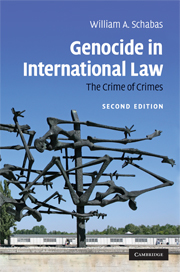Book contents
- Frontmatter
- Contents
- Preface to the first edition
- Preface to the second edition
- Acknowledgments
- List of abbreviations
- Introduction
- 1 Origins of the legal prohibition of genocide
- 2 Drafting of the Convention and subsequent normative developments
- 3 Groups protected by the Convention
- 4 The physical element or actus reus of genocide
- 5 The mental element or mens rea of genocide
- 6 ‘Other acts’ of genocide
- 7 Defences to genocide
- 8 Prosecution of genocide by international and domestic tribunals
- 9 State responsibility and the role of the International Court of Justice
- 10 Prevention of genocide
- 11 Treaty law questions and the Convention
- Conclusions
- Appendix: The three principal drafts of the Convention
- Bibliography
- Index
2 - Drafting of the Convention and subsequent normative developments
Published online by Cambridge University Press: 07 July 2009
- Frontmatter
- Contents
- Preface to the first edition
- Preface to the second edition
- Acknowledgments
- List of abbreviations
- Introduction
- 1 Origins of the legal prohibition of genocide
- 2 Drafting of the Convention and subsequent normative developments
- 3 Groups protected by the Convention
- 4 The physical element or actus reus of genocide
- 5 The mental element or mens rea of genocide
- 6 ‘Other acts’ of genocide
- 7 Defences to genocide
- 8 Prosecution of genocide by international and domestic tribunals
- 9 State responsibility and the role of the International Court of Justice
- 10 Prevention of genocide
- 11 Treaty law questions and the Convention
- Conclusions
- Appendix: The three principal drafts of the Convention
- Bibliography
- Index
Summary
Early in 1947, the Secretary-General conveyed General Assembly Resolution 96(I), declaring genocide to be a crime under international law, to the Economic and Social Council (ECOSOC). The resolution requested the ECOSOC ‘to undertake the necessary studies, with a view to drawing up a draft convention on the crime of genocide to be submitted to the next regular session of the General Assembly’. The Secretary-General suggested that the ECOSOC might assign the task to the Commission on Human Rights or to a special committee of the Council. The United Kingdom warned that the Commission on Human Rights already had a heavy programme, and proposed that the matter be returned to the Secretariat which would prepare a draft convention for subsequent review by a commission of ECOSOC.
ECOSOC's Social Committee favoured returning the matter to the Secretary-General. On 28 March 1947, ECOSOC adopted a resolution asking the Secretary-General:
(a) To undertake with the assistance of experts in the field of international and criminal law, the necessary studies with a view to drawing up a draft convention in accordance with the resolution of the General Assembly; and (b) After consultation with the General Assembly Committee on the Progressive Development of International Law and its Codification and, if feasible, the Commission on Human Rights and, after reference to all Member Governments for comments, to submit to the next session of the Economic and Social Council a draft convention on the crime of genocide.
- Type
- Chapter
- Information
- Genocide in International LawThe Crime of Crimes, pp. 59 - 116Publisher: Cambridge University PressPrint publication year: 2009



